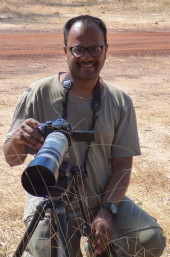One size does not fit all
In the early 2000s young researchers from Federation University, Ballarat, made important contributions to our understanding of breeding and flocking wetlands for threatened southern Brolgas. In this Ozcranes Research report author Dr K. S. Gopi Sundar explores what they discovered about how Victorian Brolgas pick and choose the wetlands they need to breed and survive throughout the year.
One size does not fit all..
Wetlands in Victoria as Brolga real estate
by Dr KS Gopi Sundar
Deep. Perennial. With vegetation. Seasonal marsh. Cattle drinking points. Protected reserves. Saline. Large size.
Wetlands in south-west Victoria fit all of these descriptions, and many more. This region has been largely converted for a variety of farming-related uses including livestock grazing, especially sheep, and crops such as canola and barley. Farmers here work the land alongside a very special Australian denizen – the Brolga.

Brolga pair between Penola, South Australia and Casterton, SW Victoria (Heatherw)
Along with farmers, Brolgas that live here face different seasonal conditions. They are potentially spoilt for choice in terms of which wetlands to choose for building nests during the breeding season, and which ones to flock in afterwards. Understanding whether Brolgas use all of the available wetlands all the time, or whether they exercise active choice, is rather important. Many wetlands used by Brolgas are on private farmlands, and such an understanding is critical to figure out which landholders to work with, for Brolga conservation. This understanding is also critical to find out if Brolgas have enough wetlands to breed and flock.
Brolga-enthusiasts working in Victoria have a huge advantage to undertake such assessments. As part of her thesis work at the Federation University Ballarat – which is a story for another time – Claire Harding created the Victorian Brolga Survey Database. This database is fed information by people who like to look at Brolgas – and there's large number of these in Victoria! People provide information on flock size, the location of sightings, and so on. In 2003, Rebecca Sheldon, also then working towards her dissertation at Federation University Ballarat, took a close look at the database to try and figure out the mystery of whether Brolgas use certain wetlands more, and whether they change their preferences at different times of the year.

Flocking Brolgas at brackish Lake Wongan, SW Victoria (Ed Dunens). The study found that SW Victorian Brolgas use higher salinity wetlands for flocking, than for breeding
Breeding Brolgas were very focused and clear about the wetlands they wanted to use. They almost only used freshwater wetlands. Or as Rebecca says in her published paper on the subject, ".. seasonal, shallow, freshwater meadows and marshes". In stark contrast, flocking Brolgas in the non-breeding season were a lot less selective. They did not even mind using saline wetlands – 35% of sites used by flocks had salty water. Significantly, flocking Brolgas like wetlands that were nearly twice as deep as the freshwater wetlands they used during breeding. None of the breeding sites had a depth of over 0.4 m, while the maximum depth of flocking sites were a full metre. More significantly, flocking Brolgas used much larger wetlands – on average 28 times bigger than the sites that they nested in. However, these wetlands used for flocking had only a quarter of the emergent vegetation that breeding sites did.
Clearly, real estate is on the mind of the average Brolga. Not any old wetland will do. Rebecca's findings show that Brolga wetland selection has clear values to Brolgas. During breeding, it makes sense for Brolga parents to choose wetlands that are much harder to see through. This allows incubating birds, and then young chicks, with cover from potential predators, and perhaps even the occasional curious farmer. During flocking, the more open wetlands likely allows the birds to get an early warning if any predator tries to get to them.
There are, of course, many other aspects of wetlands that require to be studied more carefully. Ownership of the land around the wetland is an obvious one, as is the way in which water is used from wetlands on private lands. Will land owners be able to take these findings to alter their use of wetlands in a way that is most beneficial for Brolgas, without losing too much of their livelihoods in the process? This is the million-dollar question that, as yet, remains unanswered. But thanks to Claire and Rebecca, this work adds greatly to the sparse amount of scientific information available in Brolga ecology. Such additions are very welcome. They show the huge value of citizen science efforts to collate data on the cranes, and the need for interested students to take hold of the data and try to make sense of it all.
Meanwhile, the Brolgas and the farmers continue living with each other, with wetlands being vital for both their lives and well-being. This shared value for wetlands allows an ancient species – the Brolga – to persist alongside a much newer species – the farmer. The wetlands, it appears, do fit all!

Mt Gambier landscape, South Australia. Brolgas have been satellite tracked moving between SW Victoria and Mt Gambier in South Australia (cranesnorth)
More about this work..
Abstracts from Claire Harding's and Rebecca Sheldon's Honours project theses can be read here on Ozcranes». Rebecca's published paper on her research can be downloaded from Australian Field Ornithology (free, but registration required).
About the authorGopi studied Sarus Crane nesting in the heart of densely populated farming communities in India, then completed a PhD in conservation biology at the University of Minnesota focussing on agricultural landscapes that support people and wildlife. He worked at the ICF and is an associate of NCF (India). Gopi has a deep interest in research and conservation for Brolgas and Australian Sarus Cranes.





